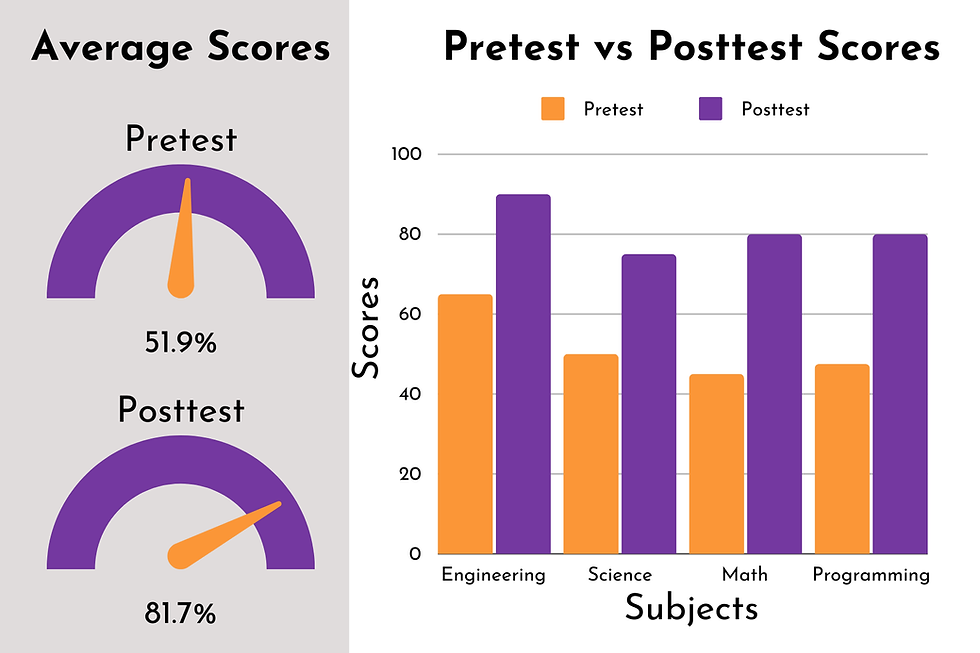Measuring Growth: The Impact of True Robotics on STEM Learning
- Vanessa Mahoney

- Aug 18, 2024
- 3 min read
Overview
At True Robotics, we are passionate about increasing the way students interact with technology and engineering concepts. Our curriculum was designed to get students excited about STEM through hands-on, experiential learning. Students get an inside look at real-world technology while also sharpening their math and science skills, leading to greater success in all STEM topics.
To assess the effectiveness of our curriculum, we developed benchmark assessments aligned with national math, science, technology and engineering standards for each grade level our curricula targets. These assessments were created using a thoughtful distribution of questions: 20% engineering-related concepts, 20% science concepts, 20% math concepts, 40% computer science and programming concepts. This approach ensures a comprehensive evaluation of students’ grasp on key STEM topics and their readiness for future challenges.
Prior to engaging with our Taking Off With Pilot (grades 4 & 5) and Introduction to Robotics with Axle (grades 6 to 8) courses, 112 students within these grades were administered our pretest for their grade level. Upon completion of our courses, the same students took a posttest revealing remarkable progress. The pretest and posttest results are as follows:


Data Analysis by Subject
As you can see in both the table and graph, there is a substantial increase in average student scores, in addition to a large increase in each of the four subjects tested.
Engineering: Students’ knowledge of engineering topics showed a significant increase of 25 percent. Students demonstrated a more detailed knowledge of the Engineering Design Process, including applying it to real-world scenarios.
Science: Knowledge of science topics increased by 25 percent! Students now have a better understanding of scientific concepts including Newton’s Laws, material properties, and waves.
Mathematics: Students' math skills improved by 35%! They mastered concepts such as volume, measurement, and number sense, all while getting hands-on experience with our robots.
Programming: Programming skills improved by 32.5%. The majority of students starting our courses have minimal coding experience. After learning with Axle or Pilot, students demonstrated a deep understanding of block-based programming including loops, if-then logic, and an understanding of ultrasonic and light sensors. They can use this knowledge to debug code and create their own programs to complete a variety of challenges.
Teacher Feedback
Student growth and engagement in STEM is a passion, but supporting teachers is just as important to us. Teachers aren’t just delivering lessons—they’re thriving too! With personalized training and an always-accessible online portal, we’re making sure they feel confident every step of the way. With our classroom packages, teachers are provided with 1 on 1 training sessions, tailored to their questions and classroom needs They are also given access to our online learning portal which provides teachers with 24/7 access to instructional materials and videos.

When surveyed, 80% of teachers felt that the materials provided were sufficient to meet their lesson objectives. Of the teachers surveyed, 60% of teachers reported a high level of preparedness in delivering the course to their students. An astounding 100% of teachers reported high levels of engagement from their students and noted academic growth as well. Other feedback provided by teachers stated that the course was successful within their classroom and that they enjoyed the flow of the course, the organization of the robot kits, and the easy access to the True Robotics team for support.
Conclusion
The progress achieved by students was nothing short of extraordinary! Coupled with the enthusiastic feedback provided by teachers, it's clear that our hands-on robotics curriculum is making a real impact. At True Robotics, we believe that collaboration with educators and students is essential to igniting a passion in STEM. By working together, we can further enhance STEM education and continue to make a difference in classrooms everywhere.

